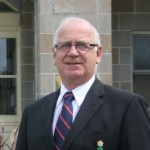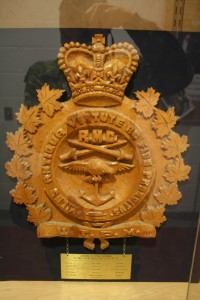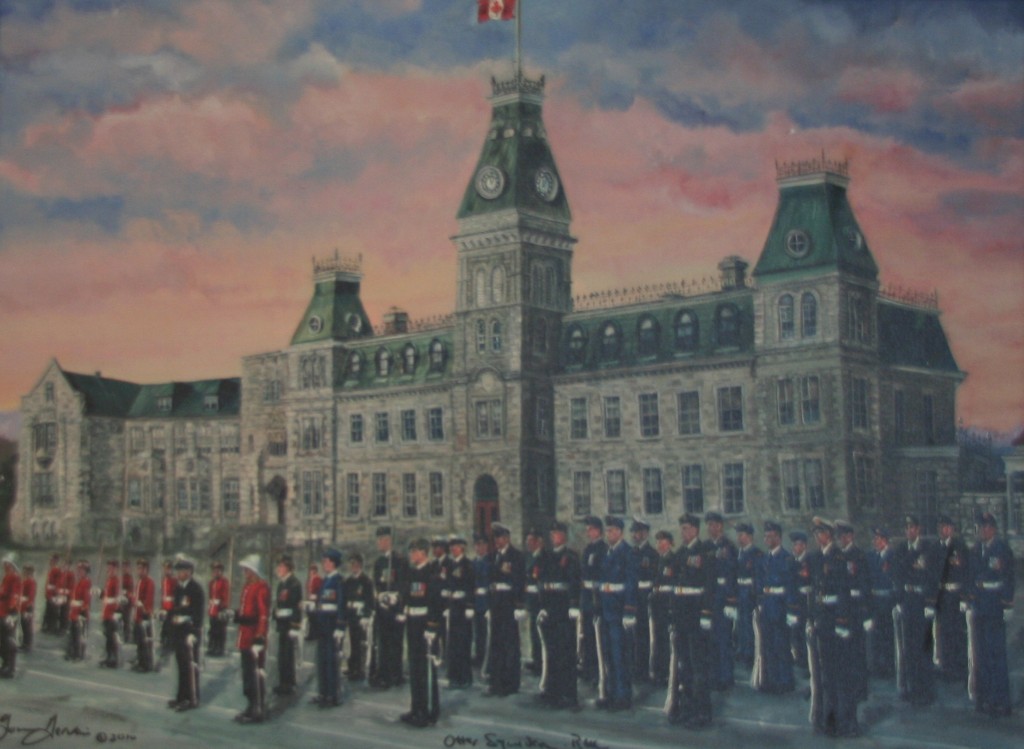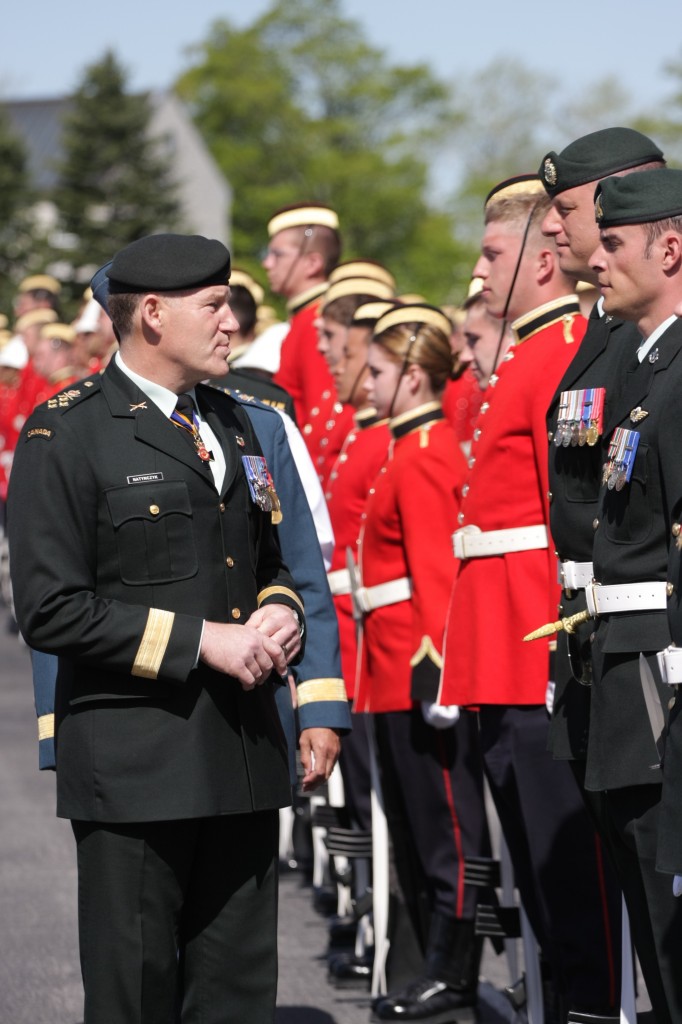
THE UNIVERSITY TRAINING PROGRAM FOR NON COMMISSIONED MEMBERS (UTPNCM) AT OUR MILITARY COLLEGES
By: M58 Marc Drolet
 The UTPNCM a very successful program which has for nearly 40 years contributed to the Military Colleges in a remarkable way.
The UTPNCM a very successful program which has for nearly 40 years contributed to the Military Colleges in a remarkable way.
For many of us who emerged from the UTPNCM, formerly called University Training Plan for Men (UTPM), the value of this outstanding training program is unquestionable. The number of years that this program has been in existence also confirms its success.
However, for those who are not familiar with the program, it may appear strange to see those non scarlet uniforms on the parade square, or those cadets who look older than average on the college grounds. As members or graduates of the UTPNCM, we like to call ourselves “UTs”. Our history and our evolution are a source of pride and we would like to share this history.
The UTPNCM program is considered one of the most successful ways to form outstanding leaders for the Canadian Forces (CF) mainly because officers emerging from the UTPNCM program can relate to the non-commissioned men and women in the CF, having been there on the “ground floor”. A UTPNCM officer naturally understands the values, needs, and aspirations of the troops, which gives them an edge as leaders in the early stages of their career as officers.
How was this program started and why?
We would need to go back to the Second World War and the Korean War to really understand why this program was put in place. It became obvious that certain military personnel in the non-commissioned ranks presented outstanding leadership and qualities expected in those serving as officers and leaders. At that same time, there was pressure to have all Officers hold University degrees. Therefore in 1948, the then three Services developed plans to subsidize university education for serving members.
 The Royal Canadian Air Force, the Royal Canadian Navy and the Canadian Army responded to this program in different ways. The RCAF embraced the program and valued the combination of natural leadership in the candidates and the desire to have science degrees. The Royal Canadian Navy crated a program called the College Training Plan (CTP) which was considered very successful. The Canadian Army only participated in this program for 3 years and discontinued the program in 1950.
The Royal Canadian Air Force, the Royal Canadian Navy and the Canadian Army responded to this program in different ways. The RCAF embraced the program and valued the combination of natural leadership in the candidates and the desire to have science degrees. The Royal Canadian Navy crated a program called the College Training Plan (CTP) which was considered very successful. The Canadian Army only participated in this program for 3 years and discontinued the program in 1950.
In 1966, when the integration of the three Services into the Canadian Forces became imminent, the UT program found a renewed source of energy. The 1960s and 1970s were a period of significant change in the Military, notably with efforts at unification, the implementation of bilingualism, etc. In June 1972 the newly appointed Chief of Defense Staff (DCS) directed that immediate steps be taken to increase the number of other ranks attending the Military Colleges on a UTPM program. This was followed in 1ater that year with direction to include the University Training Program for Officers (UTPO) program. These policies raised questions as to the effect of bringing mature students into classes with the Cadet Wing. Furthermore, the requirement for the candidates to be single had to be waived, as did the age limit.
As one can imagine, there were many questions to be answered as to how to integrate the UT program into the three Colleges. No recipe book was provided, and this new program challenged the culture in place in military colleges for almost a century.
It is not the intent here to describe the evolution of the UT program in military colleges, and anyone interested can ask for the document called “UTPM / UTPNCM history” through the editor of the e-VERITAS, Mr Bill Oliver. Rather the intent is to highlight the significant advantages of having a UTPNCM program within the walls of the Military Colleges of Canada.
Since the beginning of the UT program within the Military Colleges, it became obvious that the UT candidates bring a complementary element to an already superb institution. For having been there, I can bear witness to the close relationship between UTs and the ROTP (Regular Officer Training Program) candidates, as UTs pass on much of their military knowledge and experience acquired while in the ranks. One need only ask the staff in the various areas of the day to day life at the military college, and the same comments will be heard: UTs bring a degree of maturity to the Cadet Wing, UTs provide a lot of knowledge to the younger officer-cadets, UTs provide great examples of team spirit gained on the ground floor, and many more such comments can be heard.
I firmly believe that the UT program brings a lot of benefit to our Military Colleges. The challenge is to find the way to tap onto these outstanding resources. The evolution of the program is ongoing, but it is now clear that it has emerged as a solid part of the culture of our institutions.
When I look at the members of Otter Squadron on parade, I feel proud to be a UT, and I feel a sense of belonging. I believe that if it continues to build on its strong history, coupled with a vision which needs to come from our leadership, then it can only improve its already substantial contribution to our military institutions.
Text and translation reviewed by 10030 Michael Reid
LE PROGRAMME DE FORMATION UNIVERSITAIRE POUR NON-OFFICIER (PFUNO) AUX COLLÈGES MILITAIRES ROYAUX
par M58 Marc Drolet
 Le PFUNO est un programme couronné de succès depuis près de 40 ans et dont la contribution aux collèges militaires a été remarquable.
Le PFUNO est un programme couronné de succès depuis près de 40 ans et dont la contribution aux collèges militaires a été remarquable.
Pour beaucoup d’entre nous qui sommes issus du Programme, la valeur de cette formation exceptionnelle est incontestable. Sa longévité en est d’ailleurs le témoin. Cependant, pour ceux qui ne sont pas familiers avec le Programme, il peut sembler étrange de voir ces élèves-officiers en uniforme non écarlate sur le terrain de parade, eux qui semblent moins jeunes que la moyenne sur les terrains du Collège. Pour nous, membres actuels et anciens, qui nous qualifions d’ « UT », notre passé et notre cheminement sont source d’une fierté que nous tenons à partager.
Le PFUNO est considéré comme l’un des moyens les plus efficaces de former des chefs exceptionnels pour les Forces Canadiennes, en bonne partie parce que ses lauréats peuvent s’identifier avec les hommes et femmes du rang, ayant eux-mêmes été sur le terrain en début de carrière. Ainsi, les officiers issus du PFUNO comprennent tout naturellement les valeurs, les besoins et les aspirations des membres des FC, ce qui leur confère un avantage certain en début de leur carrière d’officier.
Comment en est-on venu à créer ce programme, et pourquoi?
Il nous faut revenir à la seconde guerre mondiale et la guerre de Corée pour comprendre pourquoi ce programme a été mis en place. Il était alors devenu évident que certains membres du rang présentaient des qualités de leadership et d’officier exceptionnelles. À cette même époque, des pressions se faisaient sentir pour que tous les officiers en viennent à détenir un diplôme universitaire. En réponse à ce besoin, les trois Armées de cette époque ont donc élaboré dès 1948 des programmes de subvention de l’enseignement universitaire pour les membres du rang en service.
L’Aviation Royale du Canada, la Marine Royale du Canada et l’Armée Canadienne ont réagi à ce projet de différentes manières. L’Aviation s’est engagée à fond, valorisant la combinaison des qualités de leadership naturel avec le désir d’obtenir un diplôme universitaire. La Marine a créé un programme appelé le « College Training Plan » (CTP) qui fut considéré une réussite. L’Armée pour sa part n’a adopté le programme que pour 3 ans seulement, le terminant en 1950.
En 1966, avec l’intégration imminente des Forces Canadiennes, le programme s’est trouvé une énergie renouvelée. Les décennies 1960 et 1970 furent une période de transformations importantes dans les FC, notamment avec le processus d’unification, l’instauration du bilinguisme, etc. En 1972 le nouveau Chef d’état-major de la Défense ordonna l’intégration immédiate du programme ‘UTPM’ (tel qu’il était appelé à l’époque) au sein des Collèges Militaires, et l’augmentation de ses effectifs. Vint aussi l’intégration du programme de formation universitaire pour les officiers (PFUO) au sein des collèges militaires. Ces décisions soulevèrent des questions portant sur l’effet qu’aurait la venue de ces étudiants plus mûrs ou plus âgés au sein de l’escadre des élèves-officiers. L’exigence pour ces étudiants d’être célibataire dut être levée, de même que la limite d’âge.
 On peut imaginer les questions qui se posèrent à cette époque sur la manière d’intégrer ces programmes au sein des trois collèges. Il n’y avait pas de manuel d’instruction à cette fin, et cette transformation mit à l’épreuve la culture qui régnait au sein des collèges militaires depuis bientôt un siècle.
On peut imaginer les questions qui se posèrent à cette époque sur la manière d’intégrer ces programmes au sein des trois collèges. Il n’y avait pas de manuel d’instruction à cette fin, et cette transformation mit à l’épreuve la culture qui régnait au sein des collèges militaires depuis bientôt un siècle.
Il ne s’agit pas ici de décrire l’évolution du programme depuis son instauration. Les personnes intéressées à approfondir leur connaissance du sujet pourront obtenir une copie de l’histoire du programme (intitulé « UTPM / UTPNCM History ») auprès de l’éditeur du e-Véritas, M. Bill Oliver. Il s’agit plutôt de souligner les avantages importants d’avoir un tel programme au sein des collèges militaires.
Dès la mise en œuvre du programme, il est devenu évident que les candidats UT contribuent un élément complémentaire auprès d’une institution qui est déjà de calibre supérieur. En tant qu’ancien de ce programme, je peux témoigner de la relation étroite que les candidats entretiennent avec ceux du Programme de formation universitaire pour officiers de la Régulière (PFUOR), en leur transmettant les connaissances et l’expérience acquise au sein des rangs subalternes. Il suffit de s’enquérir auprès du personnel cadre dans tous les domaines de la routine journalière des élèves-officiers, pour constater que les mêmes remarques reviennent constamment : les « UT » contribuent un niveau de maturité indéniable, élargissent le bagage de connaissances des jeunes élèves-officiers, démontrent un modèle d’esprit d’équipe acquis au ras des pâquerettes, et autres éloges du même crû.
Je crois fermement que le programme UT apporte beaucoup d’avantages à nos Collèges Militaires. Le défi consiste à trouver moyen de s’approprier les talents exceptionnels offerts par ses membres au bénéfice des jeunes élèves-officiers. Cette démarche est toujours en cours mais il est maintenant clair que le programme PFUNO fait bien partie de la culture de nos institutions.
Lorsque j’observe les membres de l’Escadron Otter défiler, je me sens fier d’être un UT, et je ressens un sentiment d’appartenance. Si le programme continue de se développer sur les fondations de ses solides origines, guidé par la vision de la voie hiérarchique, il ne peut qu’améliorer sa déjà vaste contribution à nos institutions militaires.





